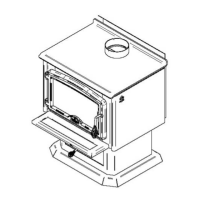Page 19
Installation and Operation Manual - 2000
ENGLISH
4.3 Blower Operation
Ensure the blower cord is not in contact with any surface of the stove to prevent
electrical shock or fire damage. Do not run cord beneath the stove.
The blower is installed on the back of the stove to increase
the flow of air past heat exchange surfaces and to help
circulate warm air in the room. When used regularly, the
blower can provide a small increase in efficiency, up to 2%.
However, the use of a blower should not be used as a way
to gain more output from a stove that is undersized for the
space it is intended to heat.
Figure 15: Air flow with a blower
The blower has a rheostat that can be adjusted in three different
positions; either from high (HI) to low (LO) or closed (OFF).
Allow the stove to reach operating temperature (approximately
one hour) before turning on the blower, since increased airflow
from the blower will remove heat and affect the start up
combustion efficiency.
It is possible to equip your stove with a heat sensor, sold
separatly. When the blower is ON, the blower will start
automatically when the stove is hot enough and it will stop
when the stove has cooled down. Therefore, you can leave the
blower speed control at the desired setting.
OFF
Figure 16: Blower operation
4.4 Your First Fires
Two things will happen as you burn your first few fires; the paint cures and the internal components
of the stove are conditioned.
As the paint cures, some of the chemicals vaporize. The vapors are not poisonous, but they do
smell bad. Fresh paint fumes can also cause false alarms in smoke detectors.
So, when you first light your stove, be prepared by opening doors or windows to ventilate
the house. As you burn hotter and hotter fires, more of the painted surfaces reach the curing
temperature of the paint. The smell of curing paint does not disappear until you have burned
one or two very hot fires.
Burn one or two small fires to begin the curing and conditioning process. Then build bigger and
hotter fires until there is no longer paint smell from the stove.

